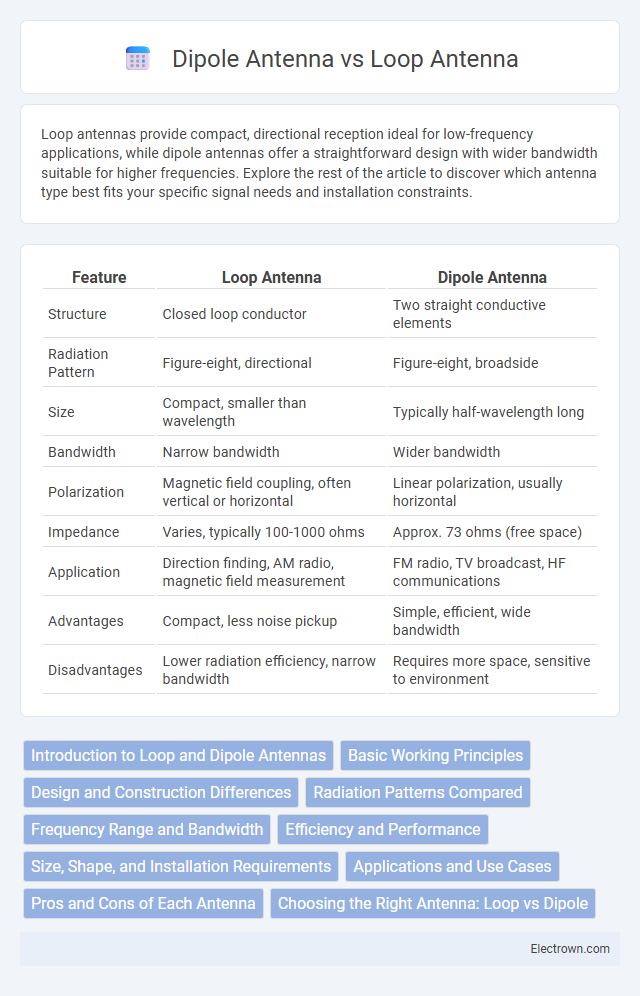Loop antennas provide compact, directional reception ideal for low-frequency applications, while dipole antennas offer a straightforward design with wider bandwidth suitable for higher frequencies. Explore the rest of the article to discover which antenna type best fits your specific signal needs and installation constraints.
Table of Comparison
| Feature | Loop Antenna | Dipole Antenna |
|---|---|---|
| Structure | Closed loop conductor | Two straight conductive elements |
| Radiation Pattern | Figure-eight, directional | Figure-eight, broadside |
| Size | Compact, smaller than wavelength | Typically half-wavelength long |
| Bandwidth | Narrow bandwidth | Wider bandwidth |
| Polarization | Magnetic field coupling, often vertical or horizontal | Linear polarization, usually horizontal |
| Impedance | Varies, typically 100-1000 ohms | Approx. 73 ohms (free space) |
| Application | Direction finding, AM radio, magnetic field measurement | FM radio, TV broadcast, HF communications |
| Advantages | Compact, less noise pickup | Simple, efficient, wide bandwidth |
| Disadvantages | Lower radiation efficiency, narrow bandwidth | Requires more space, sensitive to environment |
Introduction to Loop and Dipole Antennas
Loop antennas consist of one or more turns of wire forming a closed loop, effective for receiving low-frequency signals due to their compact size and directional properties. Dipole antennas are composed of two conductive elements extending in opposite directions, widely utilized for their simple design and efficient radiation across a broad frequency range. Both antennas serve distinct purposes in communication systems, with loop antennas favoring noise reduction and dipole antennas optimizing signal transmission and reception.
Basic Working Principles
A loop antenna operates by inducing a voltage through the magnetic field component of an electromagnetic wave, using a closed conducting loop to capture magnetic flux. In contrast, a dipole antenna functions by resonating with the electric field component of the wave, consisting of two conductive elements that receive or transmit signals via oscillating currents. The loop antenna typically exhibits a directional reception pattern and higher immunity to electric noise, while the dipole antenna provides a broad radiation pattern ideal for general-purpose communication.
Design and Construction Differences
Loop antennas feature a closed conductive loop, often circular or square, with a compact design that provides strong magnetic field sensitivity and low noise characteristics. Dipole antennas comprise two straight conductive elements aligned end-to-end, optimizing electric field reception and are generally easier to construct with telescoping or wire elements. Your choice depends on factors like available space and desired frequency range, as loop antennas excel in limited area installations while dipoles deliver broader bandwidth performance.
Radiation Patterns Compared
Loop antennas exhibit a more uniform, omnidirectional radiation pattern, making them suitable for receiving signals from multiple directions, while dipole antennas produce a figure-eight radiation pattern with pronounced nulls perpendicular to the antenna axis. The dipole's directional characteristics enable greater gain along the lobes, which can enhance signal strength in specific directions, whereas loop antennas often have lower gain but better noise rejection. Your choice between these antennas depends on whether you prioritize broad spatial coverage or focused signal reception.
Frequency Range and Bandwidth
Loop antennas typically operate efficiently in lower frequency ranges, often from a few kilohertz up to several megahertz, offering narrower bandwidth compared to dipole antennas. Dipole antennas provide a broader bandwidth and function effectively across a wider frequency range, commonly from HF (3 MHz) up to VHF and UHF bands (30 MHz to several hundred MHz). The frequency range and bandwidth differences stem from the physical size and resonance characteristics inherent to each antenna design.
Efficiency and Performance
Loop antennas generally offer higher efficiency and better noise rejection in congested urban environments compared to dipole antennas, making them ideal for receiving weak signals. Dipole antennas provide broader bandwidth and stronger gain for transmission, excelling in open areas where signal clarity and range are priorities. Your choice depends on whether you prioritize noise immunity or signal strength for optimal performance.
Size, Shape, and Installation Requirements
Loop antennas typically have a compact, circular or square shape, making them smaller and easier to install in confined spaces compared to dipole antennas, which are linear and require longer horizontal clearance for proper installation. The size of loop antennas is often determined by the wavelength of operation, generally smaller than dipoles operating at the same frequency due to the loop's multiple turns enhancing inductance. Installation of loop antennas demands careful orientation to optimize magnetic field reception, while dipole antennas require precise alignment along the transmission line's polarization for maximal signal strength.
Applications and Use Cases
Loop antennas excel in applications requiring compact design and magnetic field detection, such as direction finding, RFID systems, and portable radios. Dipole antennas are preferred for broad-range communication in broadcasting, amateur radio, and emergency services due to their efficient transmission and reception properties. Understanding your specific application needs ensures optimal antenna selection for reliable performance and signal clarity.
Pros and Cons of Each Antenna
Loop antennas offer compact size, better noise rejection, and directionality advantages, making them ideal for urban or interference-prone environments; however, they generally provide lower gain and narrower bandwidth compared to dipole antennas. Dipole antennas deliver higher gain, broader bandwidth, and simpler construction, which makes them suitable for general-purpose and long-distance communications, but their larger size and omnidirectional radiation pattern can lead to increased noise pickup. Choosing between loop and dipole antennas depends on the specific application requirements, balancing factors such as signal clarity, installation space, and frequency range.
Choosing the Right Antenna: Loop vs Dipole
Choosing between a loop antenna and a dipole antenna depends on your specific application and environmental conditions. Loop antennas excel in compact spaces and offer better noise rejection, making them ideal for urban or indoor settings, while dipole antennas provide a broader bandwidth and stronger signal for outdoor or long-distance communication. Your decision should consider factors like available space, frequency range, and interference levels to optimize antenna performance.
Loop Antenna vs Dipole Antenna Infographic

 electrown.com
electrown.com